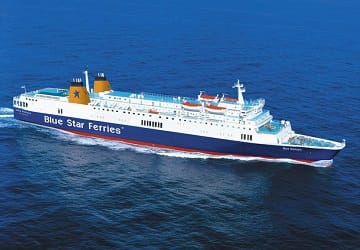
-
Recent Searches
Recent Searches
- Travel Alerts
- My Account
- Customer Service
-
United Kingdom
Paros to Patmos Ferry
The Paros Patmos ferry route connects Cyclades Islands with Dodecanese Islands and is currently operated by 2 ferry companies. The Blue Star Ferries service runs up to 2 times per week with a sailing duration of around 4 hours while the Hellenic Seaways service runs up to 2 times per week with a duration from 4 hr 30 min.
So that’s a combined 4 sailings on offer per week on the Paros Patmos route between Cyclades Islands and Dodecanese Islands. Compare now and get the best fare at the time that you want to travel.
Paros - Patmos Ferry Operators
-
- 2 Sailings Weekly 4 hr
- Get price
-
- 2 Sailings Weekly 4 hr 30 min
- Get price
Paros Guide
Located in the Cyclades group of islands, the Greek island of Paros lies in the Aegean Sea, to the west of the island of Naxos from which it is separated by a channel that is around 8 km wide. The island is 160 km to the south east of the Port of Piraeus. Historically known for its fine white marble, which gave rise to the term 'Parian' to describe marble or china of similar qualities, the marble mines and quarries have now been abandoned and can be found around the island. Today, the island's principal source of income is derived from tourism. The capital of Paros, Parikia, is a typically beautiful Cycladic village with whitewashed houses and lovely grand neoclassical mansions. Standing atop a hill in the centre of the village is a 13th century Venetian castle which provides glorious views of the town and surrounding area. There is also an important ecclesiastical attraction in the town in the form of the 6th century Church of Panayia Ekatontapyliani, also known as Katapoliani.
The island's port is also in Parikia and hosts both conventional ferries and high speed ferries. Ferries generally depart to Piraeus and to the other islands of the Cyclades.
Patmos Guide
The Greek island of Patmos is one of the Dodecanese group of islands and lies in the Aegean Sea, just off the west coast of Turkey. Skala is the port town on the island and is also the location of many of the most popular attractions. To the north of Skala is Meloi Beach with is picturesque and is shaded by trees. In the village of Hora there is the Monastery of St. John which is a popular site as is the Cave of Apocalypse which is thought to have been the sacred cave where Saint Ioannis heard the voice of God and wrote the Apocalypse. In the cave visitors are able to see the cross that was engraved by Saint Ioannis along with three small cracks in the rock through which the voice of God came, symbolising the Holy Trinity. The island is also mentioned in the Book of Revelation in the Bible where it states that its author, John, was on Patmos when he was given (and recorded) a vision from Jesus.



